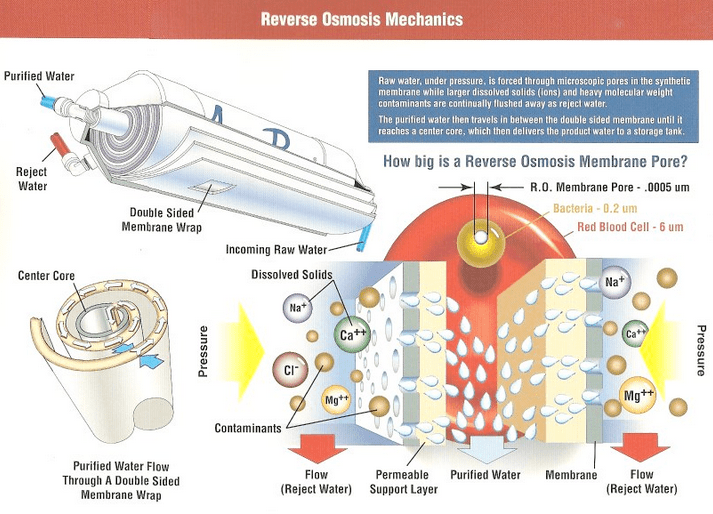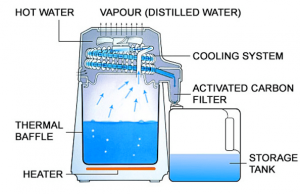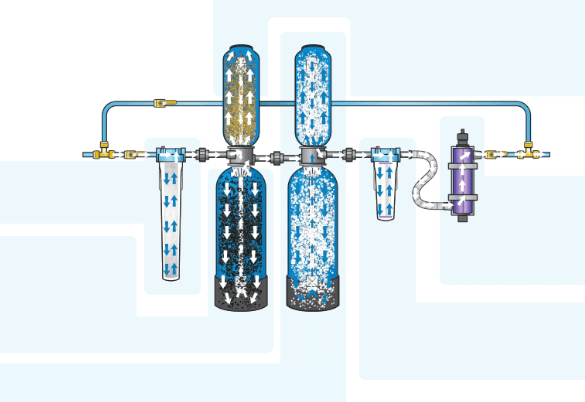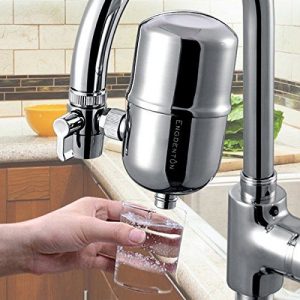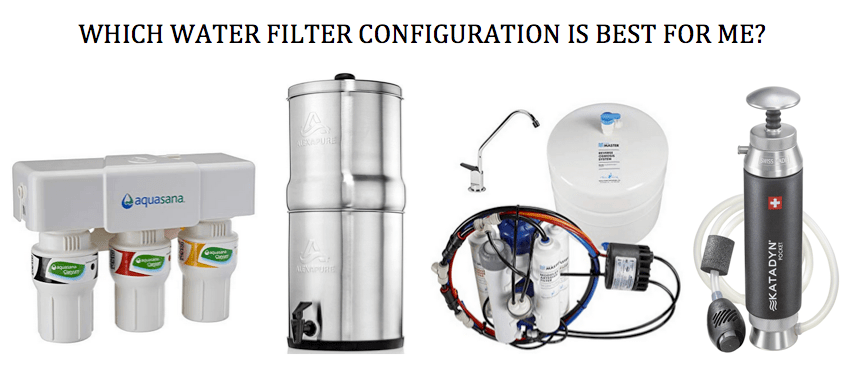
Best Water Filter: An Introduction for Beginners with FAQ
Before you decide to improve the quality of the water you drink, you need to know the basics of what the best water filter systems are and what can do for you.
Can you imagine a world with no access to clean water? Life on earth would not exist and unfortunately, there are many places where this is a reality.
While we can survive without food for 21 days, we can only survive for a maximum of 7 days if we forego water.
Water accounts for 60% of an adult body and it is vital for key functions such as the maintenance of joints and tissues, temperature regulation, and waste removal.
However sometimes we do not have access to pure water, as our water source and distribution can be contaminated by serious pollutants such as lead.
Therefore, water filtration is very important.
We invite you to join us as we discuss how the best water filter can help attain the final goal.
What is a Water Filter and How does it Work?
Basically, it is a device that has been designed and built to remove undesirable elements carried in the water (such as organic, inorganic, metals and microorganisms).
Editor’s Note
you will find that most of the filters in the market say “removes”. To be honest, I find this concept a bit questionable as it is hard to remove such components from the water; instead, I would say “reduce” to a level that is acceptable for your taste and health, as that is what a filter does. Nevertheless, no stress if you find the word “removes” everywhere.
This filtration process can occur through a number of methods (e.g, mechanical, absorption, or reverse osmosis) or through a combination of two (2) or more methods.
In order to understand how it works, let’s briefly consider the operations of each filtration method:
-
Mechanical Filtration of Water
In this case, a physical barrier is used to remove any dirt or particles from your water.
This barrier can vary from a simple mesh, which removes large particles, to a ceramic filter capable of removing tiny organisms.
If a water filter uses mechanical filtration, you will notice an assigned micron rating, which tells you the size of particles that can be removed from your water.
The smaller the value of the micron rating, then the greater the effectiveness, since harmful microorganisms can be successfully removed.
-
Adsorption (granular activated carbon – GAC) Filtration
Absorption is the most common water filtration system in our homes. Activated carbon granules easily absorb organic contaminants (such as chlorine) in your water.
The molecular structure of these carbon granules is very porous and it has an internal surface with spaces to trap impurities and boost the absorption process.
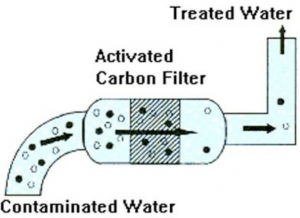
The carbon can come from wood or coconut shell, where the latter is usually included in the best water filters.
Activated carbon is created by first subjecting the raw materials to high temperatures without oxygen. In the next phase, argon and nitrogen are introduced, and then, the mixture is exposed to more heat, as well as steam and oxygen. This produces the porous carbon that is suitable for filtration.
The high-end systems contain a carbon block filter, which is more effective and carries a micron rating for removing particles.
You should note that activated carbon is not effective in removing inorganic contaminants such as arsenic and fluoride.
-
UV Filtration
This system uses the electromagnetic energy of UV light to destroy the DNA core of harmful microorganisms.
It is a powerful solution, however it requires a constant power supply to operate the UV light.
You will find that this process is commonly used in reverse osmosis systems (discussed bellow) like the Express Water RO Water Filter.
-
Sequestration
This is a form of chemical filtration, which isolates the pollutants. In this case, food-safe poly-phosphate is used to bind the calcium and magnesium deposits, which cause limescale and corrosion. This binding process neutralizes the harmful pollutants.
Although the calcium and magnesium are neutralized, they are still present and can make the water “hard”, therefore this process is best succeeded by either reverse osmosis or ion exchange.
-
Ion Exchange for water softening
Ion exchange is a popular method used to soften hard water. It works by replacing the usual calcium and magnesium ions with the alternative hydrogen and sodium ions.

When these hard minerals are removed, it is then possible to safely store water at high temperatures (such as in a coffee machine).
How does this ion exchange occur? This filtration system uses zeolite beads containing sodium ions to trap and replace the hard minerals. Once your water has no calcium and magnesium, it can be easily digested and will taste much better!.
-
Reverse Osmosis (RO)
To explain the process, this is where dissolved materials (for example calcium and magnesium ions) are removed by straining the water through a semi-permeable membrane under pressure.
The water molecules pass through, but these unwanted elements are trapped and disposed.
Reverse osmosis is a multi-filtration system which layers several filtration stages.
- The initial stage is a mechanical filter, which removes any particles solid particles that may rupture and damage the membrane.
- The second and third filters are usually carbon-based and serve to eliminate dangerous chemicals and some dissolved particles.
- The water then passes through the semi-permeable membrane, and through another filter to remove any remaining contaminants.
There may be additional processes such as UV filtration (explained above) and remineralization, which returns nutrients to the water for improved taste.
The RO process results in some amount of water waste (scum) and is best used to treat water for drinking and cooking.
While the multi-process can increase the cost (e.g, energy consumption), the gain is that this filtration method provides a great purity results, there placing this system as one of the best water filter systems.
If you want to know more about this filtration systems, check our RO guide.
-
Distillation
Distillation is probably the easiest filtration method, which anyone can use to create clean water.
- The first step is to boil the water at a temperature high enough to produce steam and to kill most of the bacteria that may be present.
- You would then capture the steam, and cool it back to its liquid state. This water would now be pure and safe for use.
Each filtration method has its limitations, so some of the best water filters use a combination of two (2) or more processes to attain a specific purity level.
Once you have an understanding of how each method works, and the possible combinations, then you will be able to figure out the kind of water filter that best fits your needs.
What are the Benefits of using the Best Water Filter?
The medical profession tells us that we should drink an average of 3.2 liters of water per day.
Let’s consider some of the health benefits of getting your daily quota of clean and sparkling water:
- Fight dehydration: Drinking your minimum intake will quench your thirst and revive your cells.
- Digestive aid: Water facilitates your digestion and helps to convert food to energy.
- Energy booster: A good digestive system allows you to easily top up your energy reserve.
- Improved performance: As your energy levels improve, so does your performance in your daily activities.
- Promote weight loss: Water helps to suppress your appetite and burn calories.
- Temperature regulation: Drinking water allows your body to release any excess heat that could damage your internal systems.
- Joints and tissue maintenance: Adequate hydration maintains the optimal moisture levels in your bones, blood and brain. Water protects your spinal cord, and it also lubricates and cushions your joints.
- Eliminate waste: Water flushes waste and toxins from your digestive and renal systems to promote overall health and well-being.
We have explored the health benefits of drinking water, however a water filter generates many other value-added benefits.
It is a cost effective way to supply potable water to homes and businesses. Bottled water can be expensive and it also leverages a high cost on the environment from the inappropriate disposal of plastic waste.
Drinking safe water reduces your risk of contracting waterborne illnesses from microorganisms and toxic chemicals.
Above all, filtered water tastes great and there’s nothing like drinking to excellent health and longevity!
Why should I have the Best Water Filter?
We can fall into the mistaken belief that once our homes receive municipal water, then we automatically have clean water flowing from our taps.
Unfortunately, this is not always the case, regardless of the size of the city, suburb or village in which we reside.
-
Contamination at Distribution Network
While water authorities do take the necessary steps to treat our water at the source, some contaminants are picked up while the water is in transit through the distribution network.
The age and length of the water mains are important factors, as corroding and long pipes result in more opportunities for contamination.
The contaminants that may be present in these feed lines include tiny organisms, as well as varied strains of bacteria and viruses. The water that reaches the end user (that’s you and I) may have an unusual color, bad smell or unpleasant taste.
These symptoms are all evidence of contamination.
-
Water Treatment at source is not good enough
The water authority’s assurance that it has done its due diligence in treating the water source is not enough. Generally such treatment plans include the use of copious amounts of chlorine.
The intended effect of chlorination is to kill microorganisms, which is generally achieved. However there are some dangerous chlorine-resistant parasites that can only be removed via mechanical filtration.
There is also the unintended side effect of chlorine and organic matter interactions, which then generate carcinogenic properties.
You also need to consider that our water source can be contaminated by pesticides and industrial chemicals, which are often fatal when ingested by humans.
If you have the capabilities to buy one, we strongly recommend that you filter the water that comes from your taps for general health and safety.
Most Common Water Filters for Home, Office and Travel
In this section, we will explore some of the most popular water filters for use in your home, office and leisure travels.
Most Common Home Water Filters
There are a variety of them for use at home. The most common products include:
Water filter pitcher: These pitchers have the appearance of a common water jug, but with a difference. They contain a cartridge which filters the water to give you a good clean cup each time.
- Water filter faucet: It just makes sense to filter your water directly from the faucet. It attaches to your faucet’s aerator and allows you to switch between tap and filtered water.
- Counter-top water filter: This system is similar to the water filter faucet, except that you have the ability to store large quantities of filtered water on your counter-top.
- Under-sink water filter: this system allows you to filter and store large quantities of water. The difference is that you don’t sacrifice any counter space. However unlike the previous systems, this one requires professional installation.
- Reverse osmosis (RO) water filter: This is probably one of the most expensive filtration systems. They are generally installed for an entire house as opposed to a specific area. A RO filter uses water pressure to force it to go through a semi-permeable membrane, and also through a series of other filters. The RO water filter is able to successfully remove a variety of contaminants.
Office Water Filters
There is some overlap between the water filters for the home and those for the office atmospheres.
There is one type that characterizes the office domain: the water cooler configuration.
The iconic office water cooler can also be fitted with filters for better water quality.
Under sink water filter systems are also commonly seen in office environments. This is because of the tiny kitchens you will find there.
Travel Devices
We know that you want to have potable water for on-the-go hydration. You never know when you will need to hydrate your body using any water surface body; if you are planning a hiking adventure or long walk trip, we recommend you find the best portable water filter.
Check our Portable Water Filter Guide to find a list of the available option in the market for 2025.
There are also straws with built-in filters, which allow people to safely drink water from any surface source. Other portable versions include micro filtration units that can be stowed in a backpack for easy transportation.
How to Choose the Best Water Filter System
Your choice of the best filter will depend on the level of your water quality. The more extensive the level of pollution, then the more complex/detailed your filtration system would need to be.
There are three (3) ways for you to determine your water quality: a water quality report, assessing the water aesthetics, and using lab tests.
-
Water Quality Report (Consumers Report)
You could contact your water authority to get the latest copy of the water quality report, also know as the consumers report, of your local water source.
You need to bear in mind that the information registered in the consumers report are related to the tests that are conducted at the treatment sites.
These tests will not account for any contamination arising from a faulty distribution network. Therefore it is ideal to conduct your water quality tests at the point of use – in your home or office.
Make sure you read these following alternatives.
-
Assessing the Water Aesthetics
You can easily assess your water quality by paying attention to its sight, smell and taste.
-
- Sight test:
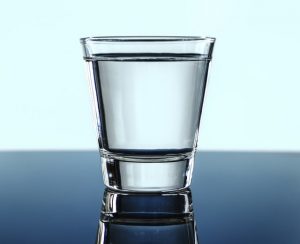
Black color may originate from chlorine breaking down the interior of your water hoses.
If you observe a white color (or just overall cloudiness), then it can mean that your water is hard due to the presence of excess calcium carbonate and magnesium carbonate.
You should let the tap run for a bit to clear out any build-up before collecting another sample.
Whether it is brown or murky, then this points to contamination from rusty pipes or pollution from another upstream source.
If it’s not possible to examine your pipes, then you can check for rust and blue stains in your toilet bowl.
A blue or white stain points to limescale deposits. In such cases, you should clean or replace your pipes. However if you determine that there are no problems with your pipes, then you should contact your water authority for more information.
-
- Smell test:
1. Chemical smell: Clean water smells fresh, so your sense of smell can provide an indication about the type of contaminants that are present. If you detect the smell of bleach, then this is likely from the chlorine treatment of the water (in excess off-course).
This smell declines the longer the water is exposed to air. You can still filter the water, but it is generally harmless.
2. H2S smell: If you notice a rotten eggs or sulfurous smell, it is most likely that the piped water has been contaminated with soils that have low pH levels.
This is most common in areas close to the sea or lakes as the groundwater table is relatively shallow, increasing the likelihood of getting exposed to oxygen.
3. Organic matter: A musty or earthy smell means that simple organic matter (for example leaves) have decayed in the water. You can conduct the similar test from the previous case of the rotten eggs smell.
This is likely a minor issue with your drains but you can filter the water just to be sure. It is most likely harmless.
-
- Taste test:
You don’t have to do this test if you think the water is suspicious, however giving a taste won’t kill you (if you don’t swallow).
If:
- the water tastes very unpleasant, don’t swallow!.
- tastes like bleach, then this is simply due to the chlorine that was used to treat the water.
- there is a metallic taste, then it can be caused from the presence of minerals or low pH levels.
- your water is salty, then this indicates sulfate contamination from irrigation and industrial drainage.
For the latter two cases, please contact your water authority.
-
Laboratory tests – Do it Yourself
You can purchase a water quality test kit to test the water that comes into your home. However, before you conduct the test, it is helpful to have an idea about the possible contaminants that may be present.
-
- What are you analyzing for
- What are you analyzing for
These include chlorine, calcium and magnesium carbonate, bacteria, viruses, pesticides, nitrates and heavy metal. Although chlorine is harmless, it makes the water taste bad.
Hard water (from calcium and magnesium) can lead to limescale deposits, while pesticides and nitrates are poisonous.
If the pH level of your water is low, then the acidity will be foul-tasting and corrode fixtures.
-
- Buying the right water test kit
You should buy a test kit that contains separate strips for the various contaminants. Each kit has detailed instructions, which you should carefully read before conducting your tests.
The instructions will outline the length of exposure of each strip to the water sample, the sample’s temperature and how to decode the colors from the tests.
You should keep each strip submerged in the water sample for the set time frame. After the time has elapsed, you should remove the strip and shake off any excess droplets.
You would then wait for the additional time to pass before comparing the strips to the color chart. If you get a hazardous reading, it is best to conduct the test once more to be sure that no errors were made.
What do you Want to Achieve by Filtering the Water?
Once you know your water quality, then you are more informed about the nature of the filtration system that you will need. Each filtration system is effective at removing certain contaminants, and so it is vital to make the right selection.
The right questions would be “What contaminant do you want to remove or reduce”?
Some of our points are:
-
Removing odor and color
Activated carbon water filters are inexpensive and effective at removing unpleasant tastes and odors, chlorine, volatile organic compounds (VOCs), and sediment.
The downside is that they do not remove bacterial growths or minerals (such as calcium and magnesium) that cause hard water. These filters must be used frequently to avoid any bacterial deposits. They are also highly time sensitive and must be regularly replaced.
-
Softening the water
Ion exchange water filters substitute hard water minerals with hydrogen and sodium ions. They are effective in removing metals, but the water may taste salty after the filtration process.
-
Killing bacteria and viruses
UV filtration is most effective in destroying bacteria and viruses, but not minerals or chemicals. They can be costly to run because they utilize electricity.
Water filters that use reverse osmosis (RO) are the most effective filtration systems. An RO system removes almost all forms of contaminants because it combines multiple filtration methods explained above.
Although there is some waste, the process generates a large volume of treated water. However a remineralization process is necessary to ensure that the end product is not bland.
Common Mistakes when Buying the Best Water Filter
Water filters come in a variety of sizes. The larger and more expensive a system is, then the greater the opportunity to make mistakes in purchasing that system. Let’s consider some of these possible mistakes:
-
Failing to do a water quality test
You should know what your water quality issues are before you purchase a filtration system. This information will guide you in the size and complexity of the system that you actually need to purchase.
-
Buying a system that’s too small (or too large)
This is a common pitfall with whole house systems. A system that is insufficient to manage the flow rates of a household will result in restrictions and eventual failure. Alternately, it is possible to buy a system that is too large and consumes more energy than needed.
-
Purchasing based on recommendations
Recommendations from friends and info from review sites should be taken with caution. You need to purchase a system that meets your specific needs and circumstances.
I know we are a site that also review water filter products but we know what the consumers need, so rest azure, you will find the necessary information to give you the right answer.
-
Buying brand names
The fluidity of company ownership and a variety of manufacture sites mean that the quality of products is not always assured. You should be willing to explore new brands, as innovative products are always being developed.
-
Buying a proprietary system
You should avoid buying a system that needs specialty parts. It’s important to consider the ease of getting replacement parts so that you will be able to maintain your water filtration system.
-
Failing to make a purchase
Last but not least, don’t get overwhelmed by all the options and fail to buy a filter. If you can afford it, a water filter (not all though) will provide, at some degree, peace of mind.
Water Filter Maintenance Tips
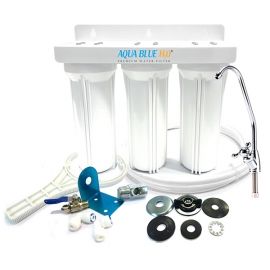
Since each system is unique, we recommend that you care for your filtration system in accordance with its own manual.
However we have general maintenance information that we can consider:
-
Change the filters
No matter the size and complexity of the filter, you should change them regularly based on:
1. Reduced water flow rate.
2.Change in water taste or color.
3. Loss of containment.
4. Last but not least, he manufacture’s recommendation to change the filter.
This last point is very important as, not always, the water will show obvious change in conditions.
-
Replace the beads
If you buy an ion exchange filter, then the beads will need to be replaced. These beads contain a limited charge, so once they have been exhausted, they become useless and your filter will no longer work.
-
Replace the bulb
If your system uses electricity, then you will need to replace the bulb. In such cases, your system may have a built-in notification to let you know when it is time for replacement. You may also be able to visually observe that the bulb needs to be replaced.
Final Thoughts about the Best Water Filter
Water is a vital resource needed to support health and well-being. However there a number of contaminants that may pollute your water at its source and during its distribution. Therefore it is important to assess your water quality and the needs of your household.
Each water filtration system must be adequately maintained according to its manual.
You will then be able to purchase a system that yields the desired level of water purity and effectively meets your household requirements.
Once you are armed with this information, you can make your personal evaluation of the best water filter available on the market.


